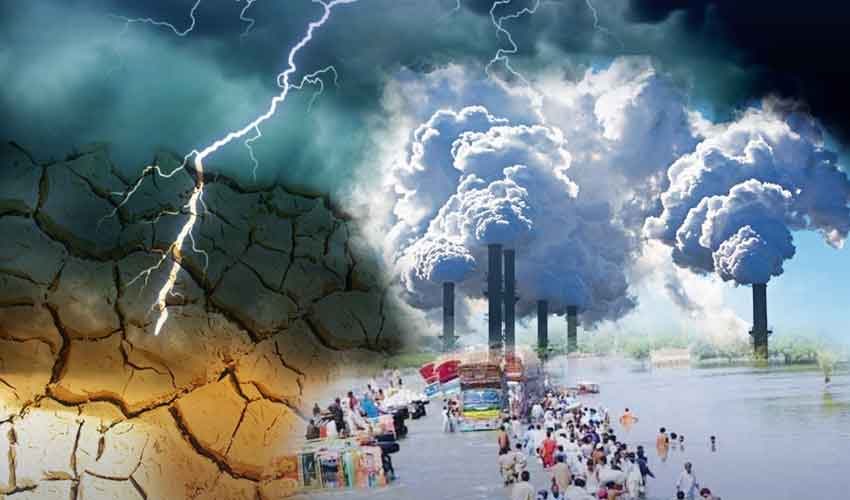The ecological conditions of Pakistan today are a complex tapestry woven from centuries of natural evolution, colonial interference, and modern industrialization. The country’s environmental landscape bears the scars of historical exploitation and contemporary mismanagement.
Colonial rule left an indelible mark on the environment of South Asia. Colonialism has destroyed the ecology of many countries, and Pakistan is no exception.
The British colonial administration in India, including present-day Pakistan, was primarily driven by economic interests. This led to the systematic exploitation of natural resources. Forests were cleared extensively to make way for plantations and infrastructure projects such as railways, which facilitated the export of raw materials to Britain. The depletion of forest cover not only disrupted local ecosystems but also contributed to soil erosion, loss of biodiversity, and alteration of local climate patterns.
Trees primarily absorb carbon dioxide (CO2) from the atmosphere. When forests are cut down, this carbon is released back into the atmosphere, contributing to global warming. Moreover, they play a crucial role in the water cycle by absorbing and releasing water. When non-regional species of plants are planted they affect the local and regional precipitation patterns and rainfall distribution.
British colonialists introduced non-native plant species such as eucalyptus and mulberry trees, which significantly altered local ecosystems. Eucalyptus and mulberry trees planted in Pakistan by colonialists consume large amounts of water to this day, exacerbating the already critical issue of water scarcity in many regions of Pakistan.
Colonial powers also introduced new agricultural practices aimed at maximizing revenue. The introduction of cash crops such as cotton, indigo, and tea replaced traditional subsistence farming.
This shift not only impacted local food security but also led to the degradation of soil quality due to the monoculture practices and extensive use of water for irrigation. Large-scale irrigation systems were constructed, such as the extensive canal systems and floodgates.
These infrastructures were designed to maximize agricultural output which was beneficial to colonialists and no attention was paid to their long-term deteriorating impacts such as waterlogging and salination of the soil. These manipulations disrupted natural water cycles and led to a significant depletion of groundwater levels, a problem that persists to this day.
The Indo-Pak water division and the subsequent control over water resources have been contentious issues since Partition. The Indus Waters Treaty, signed in 1960, aimed to address these issues by allocating water rights between the two countries, but in reality it further exploited Pakistan. The construction of dams and barrages by India on these rivers has been a point of contention and has had significant ecological and hydrological consequences for Pakistan.
India’s control over the flow of water through dams like the Baglihar Dam on the Chenab River and the Kishanganga Dam on the Jhelum River reduces the downstream flow into Pakistan.
In addition, during periods of heavy rainfall, India releases excess water from its dams to manage reservoir levels. This sudden release causes artificial flooding downstream in Pakistan. The unpredictable release of water creates a cycle of droughts and floods, making it difficult for Pakistani farmers to plan their crops. These floods not only damage crops and infrastructure but also result in soil erosion and sedimentation, further degrading the land.
Salik et al. in their study Environmental Flow Requirements and Impacts of Climate Change-Induced River Flow Changes on Ecology of the Indus Delta, Pakistan explain that the current situation poses numerous environmental challenges for the Indus Delta, including drastic reduction of sediment flux, increased salinity in agricultural fields, sea intrusion (including seawater flooding), soil erosion, and coastal retreat.
There is also a decline in mangrove cover and diversity, deterioration in marine and riverine resource bases by lowering the reproduction potential of fishes, shrimps, crabs, etc, and endangering unique riverine reptile species such as green turtles.
The legacy of colonialism is also evident in Pakistan’s rapid industrialization and urbanization, which prioritize economic growth over environmental sustainability. Lawrence Wood in her thesis, The Environmental Impacts of Colonialism, suggests that the industrial revolution necessitated colonial resource extraction, creating a feedback loop between industrialization and imperialism. This cycle led to environmental degradation as natural resources were exploited without regard for ecological consequences.
Elizabeth DeLoughrey and George Handley in their book, Postcolonial Ecologies: Literatures of the Environment, exclaim that the colonial administration's division of the landscape into the "plains" and the "hills" illustrates how space was ideologically constructed. The plains were depicted negatively, as disease-ridden and monotonous, while the hills were romanticized as pristine and unspoiled. This demonstrates a biased and reductionist view that justified different treatment and policies for these regions.
This ideological construction influenced environmental policies and exploitation strategies. The plains, being seen as less valuable and more expendable, were subjected to intensive agricultural practices, deforestation, and resource extraction. In contrast, the hills were often preserved as exclusive retreats for the colonial elite or used strategically for military and administrative purposes.
The differing treatment of these regions led to long-term ecological consequences. The exploitation of the plains for agriculture and resources led to soil degradation, deforestation, and loss of biodiversity. The hills, although less exploited, were not immune to environmental changes due to the construction of infrastructure and changes in land use imposed by colonial policies.
This bifurcation also had cultural and socio-political effects, marginalizing local populations and disrupting traditional land use practices. The depiction of the plains' inhabitants as "idol-worshipping, disease-ridden people" reflects a dehumanizing attitude that justified colonial exploitation and control.
Today, Pakistan faces significant environmental challenges due to this historical backdrop. Rapid industrialization and urbanization have led to deforestation, loss of habitats, and the depletion of natural resources. The widespread use of chemical fertilizers has further exacerbated these problems, leading to soil degradation and reduced agricultural productivity. Deforestation, in particular, has had a profound impact on flood control, reducing the natural absorption of rainwater and increasing the risk of flooding.
The environmental degradation in Pakistan has serious health implications for its population. The depletion of natural resources and the pollution caused by industrial activities have led to health hazards.
Industrial activities release large quantities of pollutants such as carbon dioxide (CO2), sulfur dioxide (SO2), nitrogen oxides (NOx), and particulate matter into the atmosphere which can cause respiratory and cardiovascular diseases, and long-term exposure can lead to chronic health issues including waterborne diseases. Low oxygen levels in urban areas, driven by deforestation and pollution, contribute to poor air quality and associated health risks.
Besides, factories often discharge untreated or inadequately treated wastewater into rivers, lakes, and oceans, contaminating water sources with heavy metals, chemicals, and other pollutants. Improper disposal also leads to the bioaccumulation of harmful substances in the food chain.
Most importantly, industries are major sources of greenhouse gases, particularly CO2 and methane (CH4), which trap heat in the atmosphere and contribute to global warming. Climate change in Pakistan has led to more frequent and severe weather events such as hurricanes, floods, and droughts, impacting both human and natural systems.
Colonialism’s impact on Pakistan’s environment extends beyond physical changes to include an ideological shift towards eco-phobia. This exploitation-oriented approach has contributed to the increasing bareness of lands and the import of agricultural products to meet domestic demands.
Cole Harris (2004) argues that colonialism dispossesses land not just through removal but also through the coordination of physical violence, discursive justification, and ongoing physical occupation. This comprehensive dispossession has left Pakistan grappling with the ecological consequences of its colonial past and the challenges of sustainable development in the face of modern economic pressures.
Addressing Pakistan's ecological challenges requires acknowledging the colonial legacy and modern mismanagement that have led to deforestation, water scarcity, and pollution. Immediate actions include large-scale reforestation with native species, sustainable water management, strict industrial pollution regulations, and the promotion of sustainable agricultural practices.
Raising public awareness through education is crucial. Collaboration between government, NGOs, businesses, and citizens is essential to mitigate ecological damage and ensure a sustainable future. Prioritizing these measures will help restore and preserve Pakistan's environment for future generations.
The writer is a student of BS English Literature from the Government College University, Lahore.



























